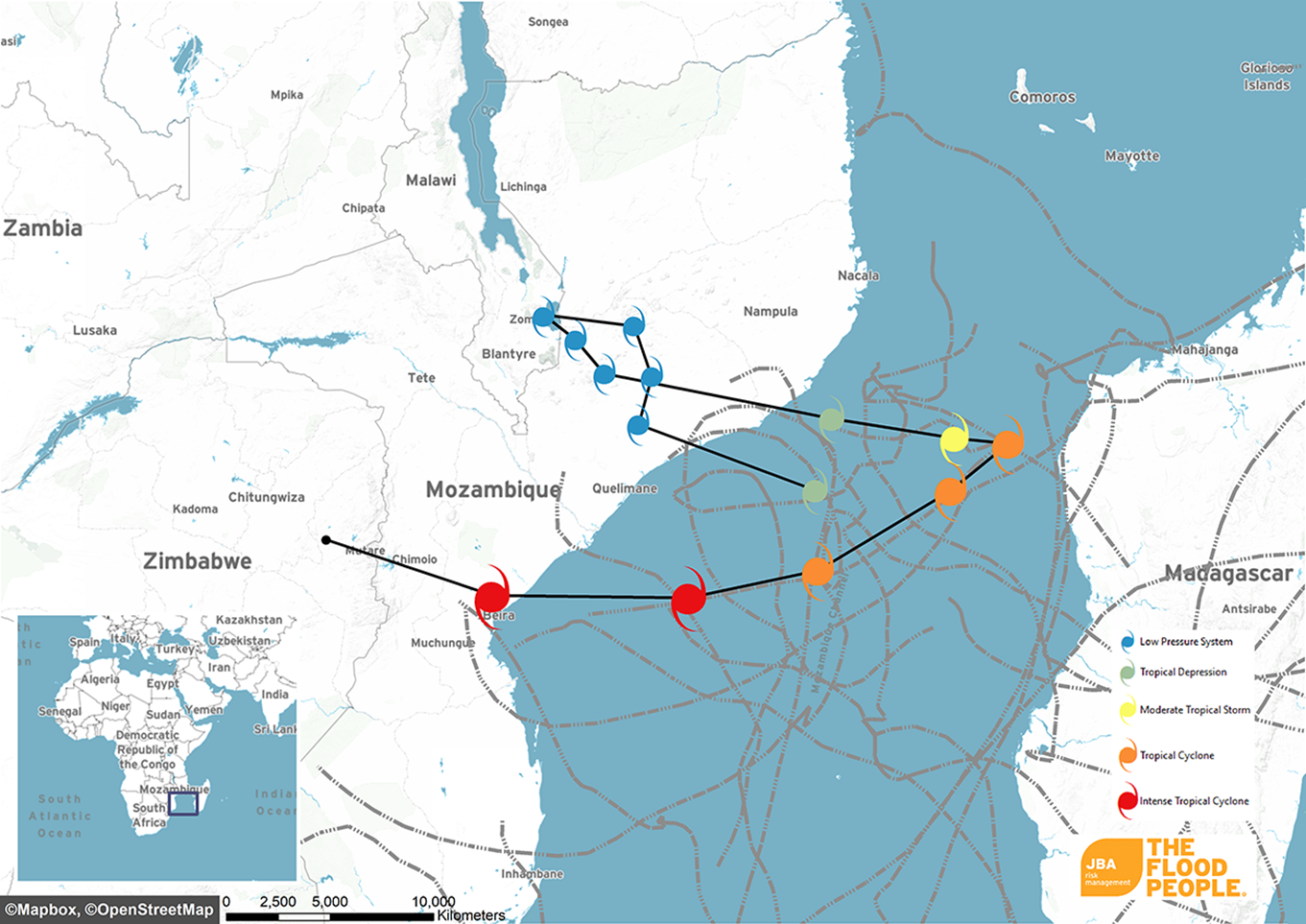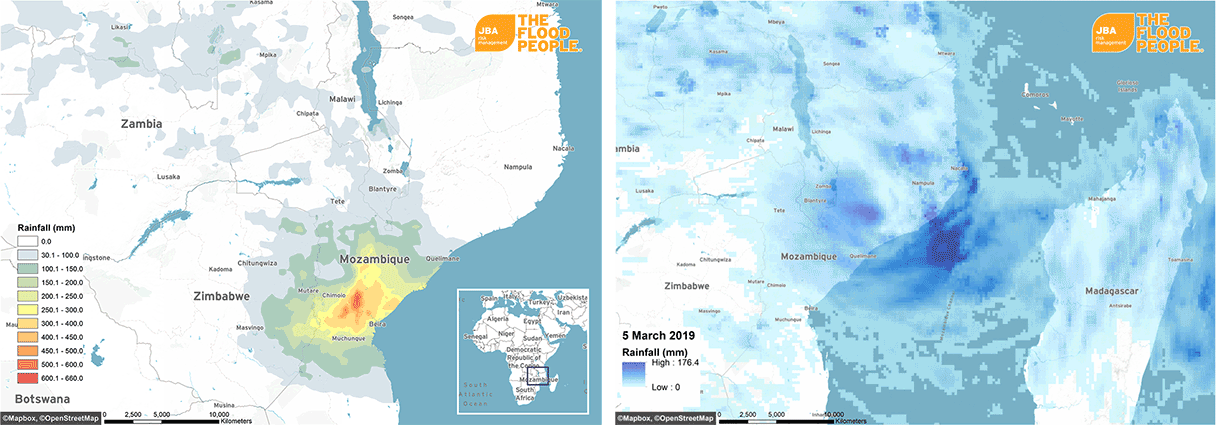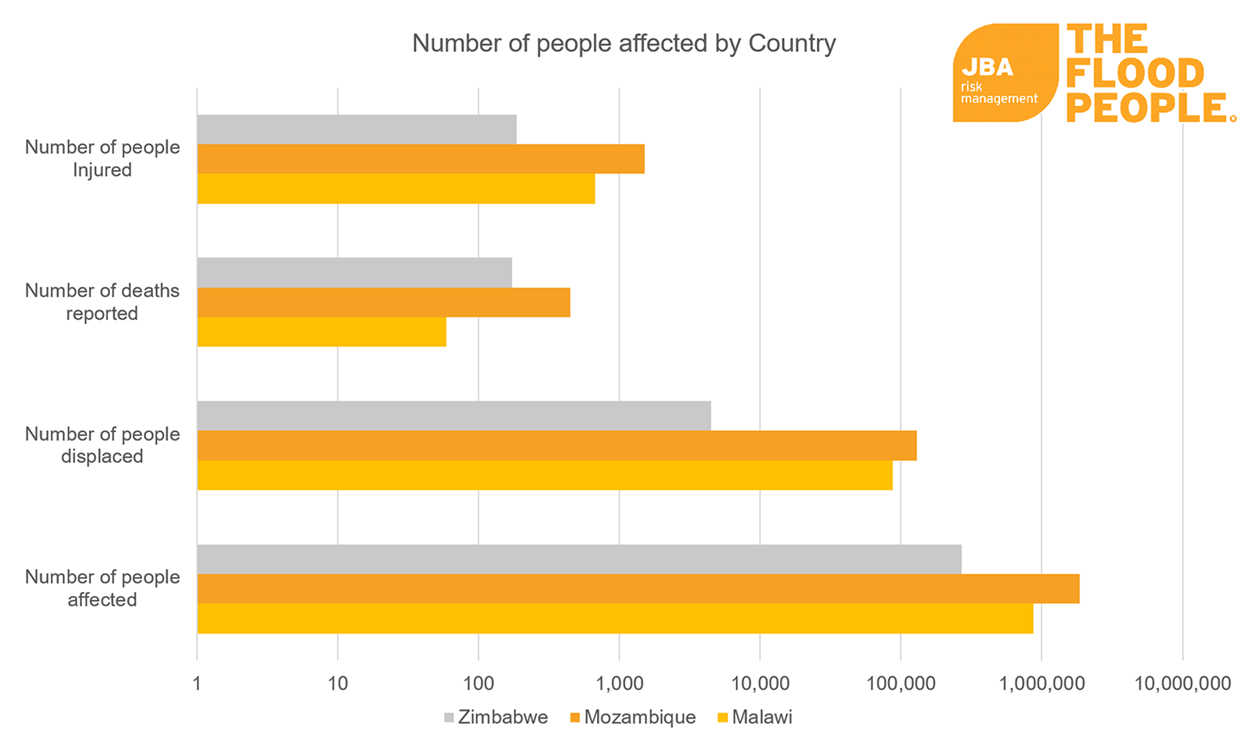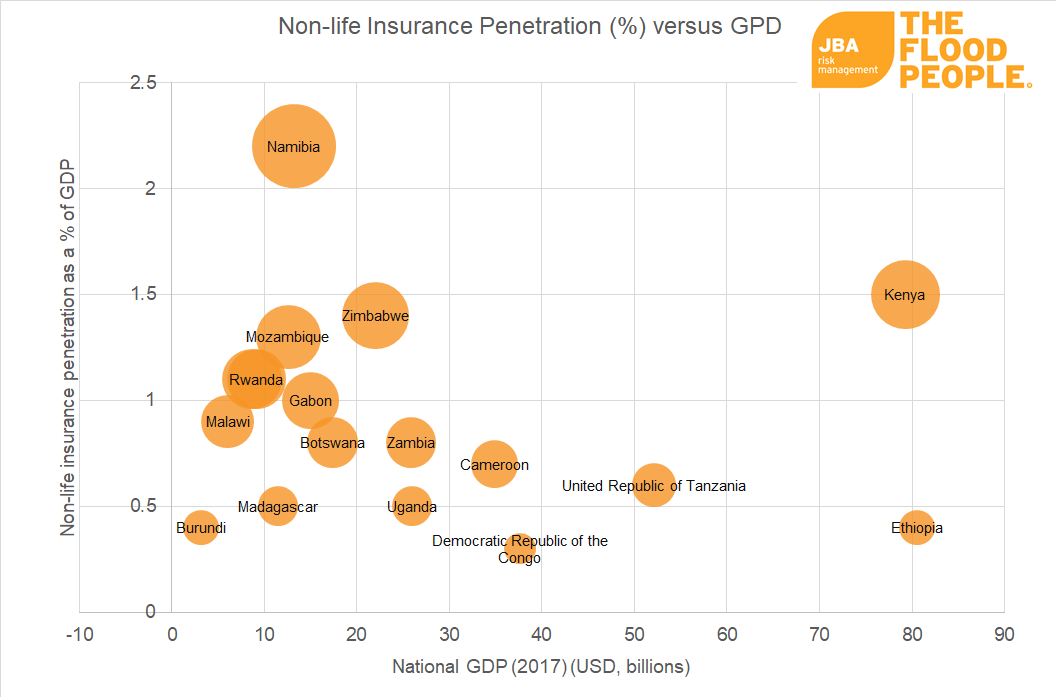Cyclone Idai made landfall near the city of Beira in Mozambique around midnight (CAT) on 15 March 2019 with wind speeds of up to 177km/hr (Beaumont, 2019a). Cyclone Idai had originally developed as a tropical depression in the Mozambique Channel - an area of warm water located between Mozambique and Madagascar. It first made landfall in north Mozambique before returning to the Mozambique Channel and re-intensifying (Figure 1). While moving westward in the Mozambique Channel, the tropical depression developed into an intense tropical cyclone.
 Figure 1: Track of Cyclone Idai from 4-16 March 2019. The intense tropical cyclone made landfall close to Beira, a port city in Mozambique. The grey lines represent storm tracks recorded between 2010 and 2019 on JWTC track database . Cyclone Idai track data source: Météo France, 2019.
Figure 1: Track of Cyclone Idai from 4-16 March 2019. The intense tropical cyclone made landfall close to Beira, a port city in Mozambique. The grey lines represent storm tracks recorded between 2010 and 2019 on JWTC track database . Cyclone Idai track data source: Météo France, 2019.
Impacts of Cyclone Idai
The landfall of Cyclone Idai resulted in extreme levels of precipitation and strong winds across south-east Africa, predominantly affecting Mozambique, Malawi and Zimbabwe (Reid, 2019). The prolonged rainfall caused flash (surface water) and riverine flooding in the Chipinge and Chimanimani districts in Zimbabwe, as well as in Malawi and Mozambique (Figure 2).
 Figure 2: Extent of flooding seen from satellite imagery (left; image source: ReliefWeb) compared with JBA’s 1-in-100-year Mozambique 30m river flood map for the area around the Buzi river basin in east Mozambique (JBA Risk Management Limited™). The extent of flooding observed in the Buzi river basin based on JBA’s flood map is comparable to the flood extent observed by satellite data.
Figure 2: Extent of flooding seen from satellite imagery (left; image source: ReliefWeb) compared with JBA’s 1-in-100-year Mozambique 30m river flood map for the area around the Buzi river basin in east Mozambique (JBA Risk Management Limited™). The extent of flooding observed in the Buzi river basin based on JBA’s flood map is comparable to the flood extent observed by satellite data.
Prolonged rainfall inundated the surroundings of Beira: total rainfall across the five-day period from 13 to 18 March ranged from 250–660mm (Figure 3; Video 1).
 Figure 3: Rainfall accumulation from 13-15 March 2019, based on daily precipitation data collected by NASA Precipitation Measurement Missions (left) and video (right) showing daily rainfall between 5 and 10 March 2019. (Data source: NASA PPM, 2019; video produced by JBA Risk Management Limited™).
Figure 3: Rainfall accumulation from 13-15 March 2019, based on daily precipitation data collected by NASA Precipitation Measurement Missions (left) and video (right) showing daily rainfall between 5 and 10 March 2019. (Data source: NASA PPM, 2019; video produced by JBA Risk Management Limited™).
The United Nations (UN) has identified the cyclone event as one of the worst disasters to occur in the southern hemisphere (Maclean, 2019). Based on data released by ReliefWeb on 26 March 2019, a total of 678 deaths have been reported. Mozambique has suffered the most reported fatalities (447), with 172 deaths in Zimbabwe and 59 in Malawi (OCHA, 2019c). However, these figures are expected to increase rapidly over the coming days as flood waters start to recede and the scale of the catastrophe becomes clearer (Beaumont, 2019). 220,000 people have been displaced from their homes in all three countries, and more than 2.6 million are believed to have been affected by the event (Figure 4) (Maclean, 2019).
 Figure 4: Number of people affected in Zimbabwe, Mozambique and Malawi due to the floods caused by Cyclone Idai. (Data source: ReliefWeb).
Figure 4: Number of people affected in Zimbabwe, Mozambique and Malawi due to the floods caused by Cyclone Idai. (Data source: ReliefWeb).
An additional concern is the number of cholera cases, which is increasing daily. At the time of writing, there have been 138 confirmed cases of cholera in the port city of Beira, which has a population of ~500,000 (Beaumont, 2019b; Reuters, 2019). Additionally, a total of 12,308 structures have been destroyed in the city, with an estimated 39.4% of structures located in the Chota neighbourhood (OCHA, 2019b). In Mozambique, a total of 91,000 houses were officially identified as inundated (OCHA, 2919b) (Table 1). Many walls and roofs of houses were damaged due to the strong winds, while the properties’ contents have been severely damaged by the floods.
 Table 1: Number of houses inundated in Mozambique (OCHA, 2019)
Table 1: Number of houses inundated in Mozambique (OCHA, 2019)
Historical Events
Tropical cyclones commonly develop in the south-west Indian Ocean basin between October and May, with peak season from mid-January to March.
Between 1950 and 2000, fewer than 5% of the tropical cyclones that developed in the south-west Indian Ocean made landfall in south-east Africa (Reason and Keibel, 2004). Results from this research show that conditions during La Niña years (e.g. higher precipitation) are associated with enhanced sea surface temperatures and higher probability of occurrences of tropical cyclones on the Mozambique coastline (Reason and Keibel, 2004).
An average of 1.5 cyclones hit Mozambique during an annual cyclone season (Leahy, 2019). In February 2000, weeks of continuous rainfall and Cyclone Eline caused the Limpopo and Save rivers to burst their banks (McGreal, 2000). One million people were left homeless due to the floods and hundreds of lives lost. It was estimated that the floods that year may have caused a 10-year setback in the growth of Mozambique’s economy (McGreal, 2000). A total of five cyclones formed near Madagascar and Mozambique in 2000, which were linked to the unusually warm sea surface temperature (Reason and Kiebel, 2004).
Prior to Cyclone Idai, a total of six intense tropical cyclones developed in the basin during the 2018-2019 cyclone season (NASA, 2019). Looking ahead, a recent study suggested that oceans are warming at 40-50% faster than figures published in the last IPCC report, which may enhance tropical cyclone activity in the region (Fritz, 2019). Research also suggests that climate change may contribute to higher intensities of rainfall and tropical cyclone events in the future, therefore exacerbating the impact of cyclones such as Idai.
Current rates of insurance penetration and financial losses from flood risk
Floods and cyclones are the hazards most accountable for economic losses and mortality in Mozambique based on national data for hazard losses between 1990 and 2014. Flood accounts for 45.6% of all fatalities in Mozambique, making it the country’s primary hazard. The total economic loss for cyclone, flood , storm and rainfall accounted for more than 97% of total economic losses of all disasters, regardless of scale, in Mozambique between 1990 and 2014 (PreventionWeb, 2019). The average annual losses for flood and wind are USD $39 million and USD $38.72 million respectively (PreventionWeb, 2019).
The severe flooding and wind damage caused by Cyclone Idai has destroyed infrastructure worth more than USD $1 billion, according to the UN Economic Commission for Africa (Nhamire and Hill, 2019). At least 90,000 houses have been destroyed, as well as school buildings, roads and more than 500,000 hectares of crops, with most being close to their annual harvest.
Although Malawi, Mozambique and Zimbabwe have slightly higher insurance penetration than other countries in Africa, it is still very low, at 0.9%, 1.3% and 1.4% respectively (Swiss Re Institute, 2017; Figure 7).
 Figure 7: Comparison of non-life insurance penetration versus national GDP for several countries in Africa. (Data: World Bank and Swiss Re Institute, 2017).
Figure 7: Comparison of non-life insurance penetration versus national GDP for several countries in Africa. (Data: World Bank and Swiss Re Institute, 2017).
JBA Risk Management has nationwide return period flood maps available for Mozambique, Malawi and Zimbabwe at 30m resolution. For more information, get in touch.
References
Beaumont, P. 2019. 'The water took everything': Buzi evacuees tell of Cyclone Idai ordeal. The Guardian. [online] Available at: https://www.theguardian.com/global-development/2019/mar/22/the-water-took-everything-buzi-evacuees-tell-of-cyclone-idai-ordeal [Accessed 28 Mar. 2019].
Beaumont, P. 2019b. Cyclone Idai crisis deepens as first cases of cholera confirmed in Mozambique. The Guardian. [online] Available at: https://www.theguardian.com/global-development/2019/mar/27/cyclone-idai-first-cases-of-cholera-confirmed-beira-mozambique [Accessed 28 Mar. 2019].
Fritz, A. 2019. The oceans are warming faster than we thought, and scientists suggest we brace for impact. The Washington Post. [online] Available at: https://www.washingtonpost.com/weather/2019/01/11/oceans-are-warming-faster-than-we-thought-scientists-suggest-we-brace-impact/?utm_term=.3a35a002f435 [Accessed 29 Mar. 2019].
Leahy, S. 2019. Why Cyclone Idai was so destructive. [online] Available at: https://www.nationalgeographic.com/environment/2019/03/why-mozambique-cyclone-idai-was-so-destructive/ [Accessed 28 Mar. 2019].
Maclean, R. 2019. Cyclone Idai 'might be southern hemisphere's worst such disaster'. The Guardian. [online] Available at: https://www.theguardian.com/world/2019/mar/19/cyclone-idai-worst-weather-disaster-to-hit-southern-hemisphere-mozambique-malawi [Accessed 28 Mar. 2019].
McGreal, C. 2000. Rescuers struggle as waters rise. The Guardian. [online] Available at: https://www.theguardian.com/world/2000/feb/29/mozambique.chrismcgreal [Accessed 28 Mar. 2019].
Météo France. 2019. Idai: Cartographie Trajectoire. [online] Available at: http://www.meteo.fr/temps/domtom/La_Reunion/webcmrs9.0/francais/activiteope/data/20182019/2018RE11.html [Accessed 29 Mar. 2019].
NASA Earth Observatory. 2019. Tropical Cyclone Idai Aims at Mozambique. [online] Available at: https://earthobservatory.nasa.gov/images/144667/tropical-cyclone-idai-aims-at-mozambique?src=eoa-iotd [Accessed 28 Mar. 2019].
Nhamire, B. and Hill, M. 2019. Tropical Cyclone Idai Destroyed More Than $1B of Southern Africa Infrastructure: UN. [online] Available at: https://www.insurancejournal.com/news/international/2019/03/26/521672.htm [Accessed 28 Mar. 2019].
PreventionWeb. 2019. Mozambique Disaster & Risk Profile. [online] Available at: https://www.preventionweb.net/countries/moz/data/ [Accessed 29 Mar. 2019].
REACH Initiative. 2019. Mozambique - Beira City, Number of Flood Inundated Structures by Neighbourhood - As of 19 March 2019. [online] Available at: https://reliefweb.int/report/mozambique/mozambique-beira-city-number-flood-inundated-structures-neighbourhood-19-march [Accessed 28 Mar. 2019].
Reason, C. and Keibel, A. 2004. Tropical Cyclone Eline and Its Unusual Penetration and Impacts over the Southern African Mainland. Weather and Forecasting. 19(5), pp.789-805.
Reid, K. 2019. 2019 Cyclone Idai: Facts, FAQs, and how to help | World Vision. [online] World Vision. Available at: https://www.worldvision.org/disaster-relief-news-stories/2019-cyclone-idai-facts [Accessed 28 Mar. 2019].
Reuters. 2019. Cholera cases jump to 138 in Mozambique’s Beira after cyclone. [online] Available at: https://www.reuters.com/article/us-africa-cyclone-cholera/mozambique-confirms-138-cholera-cases-after-cyclone-strikes-beira-idUSKCN1RA0UG [Accessed 29 Mar. 2019].
Swiss Re Institute. 2017. Insurance penetration (Non-Life). [online] Available at: http://www.sigma-explorer.com/ [Accessed 29 Mar. 2019].
UN Office for the Coordination of Humanitarian Affairs (OCHA). 2019a. Zimbabwe: Floods Flash Update No. 1, 17 March 2019. [online] Available at: https://reliefweb.int/report/zimbabwe/zimbabwe-floods-flash-update-no-1-17-march-2019 [Accessed 28 Mar. 2019].
UN Office for the Coordination of Humanitarian Affairs (OCHA). 2019b. Mozambique: Cyclone Idai & Floods Flash Update No. 10, 26 March 2019. [online] Available at: https://reliefweb.int/report/mozambique/mozambique-cyclone-idai-floods-flash-update-no-10-26-march-2019 [Accessed 28 Mar. 2019].
UN Office for the Coordination of Humanitarian Affairs (OCHA). 2019c. Southern Africa: Cyclone Idai Snapshot (as of 26 March 2019). [online] Available at: https://reliefweb.int/report/mozambique/southern-africa-cyclone-idai-snapshot-26-march-2019 [Accessed 28 Mar. 2019].